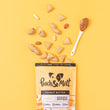
FREE UK DELIVERY ON ORDERS OVER £39.99
There’s nothing like walking your dog during the warmer spring and summer months. But, if you’re passing any lakes or ponds with a bright green film on the surface, this is a warning to you and your dog to steer clear, instead of taking a cooling dip.
Blue-green algae form on still water and are extremely dangerous, or even fatal, to your pooch if they ingest it or it comes into contact with their skin. In this article, we’ll explain what blue-green algae is, how to identify it, and how to keep your dog safe from its toxic effects.
Blue-green algae looks like a paint-like film on top of water and wet surfaces, and it’s not actually algae at all, but Cyanobacteria.
Usually it’s green but it can also be blue, brown or red. Sometimes there is foam, and often, an unpleasant smell.
This bacterium gathers and breeds in wet places, particularly on still or stagnant water like lakes, ponds or lagoons. When you see a pond that is covered in green, it might look scenic, but you and your pooch shouldn’t go anywhere near it.
Not all algae is blue-green algae, but the risk is that it’s often difficult to tell the difference.
Bodies of freshwater that are still or slow-moving are a prime spot for the Cyanobacteria to thrive and create blue-green algae.
Lakes, lagoons, ponds, brackish areas (where freshwater meets the sea), even coastal pools or marshes can be susceptible to breeding these toxic bacteria.
Another risk worth noting is that you won’t always see the blue-green algae. It doesn’t only present as a green film on the surface of water, but is sometimes in the water.
Still water that has a murky, milky quality is prone to having these bacteria swimming within its depths. This is why you should be especially vigilant and put your dog on a lead if they have a tendency to run, jump or drink water whenever they see it.

Blue-green algae is severely toxic if your dog ingests it, but it can be poisonous even if it gets on your dog’s skin or fur.
This is because it releases two types of toxins that can be absorbed into the body, Neurotoxins and Hepatotoxins. Put simply, these toxins can make your dog severely unwell, and can prove fatal, sometimes immediately.
Neurotoxins attack your dog’s nervous system. This can lead to:
Hepatotoxins attack the dog’s liver and can cause further damage around the body if untreated.

If your pooch has come into contact with blue-green algae, consider it an emergency and immediately watch out for the following symptoms:
Almost immediately.
You may see symptoms appear within five minutes to a few hours of your dog coming into contact with the algae.
In some cases, there isn’t a slow onset of symptoms and the severe signs could trigger straight away. This makes contact with blue-green algae a medical emergency for your pooch. As soon as you know they have touched, licked or drunk it, call your vet.

Prevention is always better than a cure when it comes to these dangerous toxins, so be prepared to keep your dog safe from blue-green algae.
If you catch your dog drinking from a source of blue-green algae, stop them from doing so and immediately call your vet or take them straight to an emergency vets. Don’t try to induce vomiting, just keep them warm and safe, and watch out for the onset of any symptoms.
If your pooch has jumped into an algae pond or body of water, directly and clearly order them to get out of the water (it helps if they have a strong call-back response). Do all you can to prevent them from licking or grooming themselves, find clean water to wash as much of it off and then, if possible, dry them down with a towel. Call your vet or an emergency vets straight away and watch out for any symptoms that might appear.
Dogs with blue-green algae poisoning will need emergency treatment as symptoms can be lethal.
A vet will treat any symptoms that are currently presenting, and induce vomiting (but don’t do this yourself).
Not all algae is toxic, but annoyingly, it can be hard to know the difference. Any green film that appears in your dog’s water bowl could either make your dog slightly unwell or extremely sick, so you should always clean out your pooch’s bowls with soap and water at the end of each day. Also, don’t forget to empty and clean bowls that may have been left outside, as these are particularly at risk of breeding bacteria.
There can be all kinds of bacteria in pond water that can cause grief in your pooch’s gut, especially with the diversity of their gut microbiome. Some are mildly harmful, and others are dangerous. If you suspect your pooch may have come into contact with blue-green algae (a green, soup-like film that gathers on the surface of still water), you should definitely call a vet straight away, as diarrhoea could be a symptom of dangerous blue-green algae poisoning. In any case, you might want to switch to dog food for sensitive tummies while they recover.
Regular algae isn’t toxic to dogs like blue-green algae is, but the danger lies in how hard it is to tell the difference. While natural algae might form in patches in freshwater lakes and streams, blue-green algae smells bad and appears more scummy; it has a soup-like quality, sometimes with foam, and gathers in stagnant, wet places. Generally, it seems more chemical than natural (like regular algae).
Ideally, no - the older the water, the more likely bacteria has had time to develop. This includes days-old water in a dog bowl (which is probably the lowest risk), and water in puddles and ponds, which can be swarming with nasty parasites and harmful bacteria. Deter your dog from drinking dirty water by saying ‘No’, always having clean water on hand to quench their thirst, and putting them on the lead whenever you pass by still water, such as ponds covered in algae.
If your pooch gets sickness or diarrhoea from something they’ve ingested, consider switching to dog food for sensitive tummies. The gently digestible, natural ingredients and a burst of powerful probiotics help replenish the good bacteria in your pooch’s gut, so they feel back to their normal selves in no time.





Never miss a treat!
Subscribe to our newsletter and get blog articles amongst other treats delivered to your inbox






Comments (0)
Leave a comment